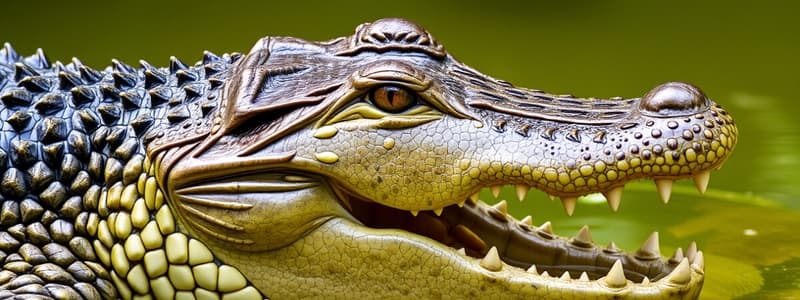Podcast
Questions and Answers
What is Crocodylinae?
What is Crocodylinae?
- A type of alligator
- An extinct reptile
- A freshwater habitat
- A subfamily of true crocodiles (correct)
What is the scientific name of the saltwater crocodile?
What is the scientific name of the saltwater crocodile?
Crocodylus porosus
What is the lifespan of a Nile crocodile?
What is the lifespan of a Nile crocodile?
70 - 100 years
What is the maximum speed of an American crocodile in water?
What is the maximum speed of an American crocodile in water?
Freshwater crocodiles primarily eat invertebrates.
Freshwater crocodiles primarily eat invertebrates.
What does Alligatoridae refer to?
What does Alligatoridae refer to?
What is the common name for Alligator mississippiensis?
What is the common name for Alligator mississippiensis?
What is the length of the Chinese alligator?
What is the length of the Chinese alligator?
What is Alligator prenasalis?
What is Alligator prenasalis?
Study Notes
Crocodylinae
- Crocodylinae is a biological subfamily that includes true crocodiles.
- These large aquatic reptiles inhabit tropical regions of Africa, Asia, the Americas, and Australia.
Crocodylus porosus (Saltwater Crocodile)
- Known as the largest living reptile and riparian predator in the world.
- Lifespan: Up to 70 years for adults.
- Can reach speeds of 15-18 mph in water during short bursts.
- Male weight ranges from 880 to 2,200 lbs, females weigh 180 to 220 lbs.
- Length: Males usually measure 14-17 ft, while females average 7.5-11 ft.
- Unique adaptation: Mouth has a valve to seal off the throat, allowing underwater mouth opening.
Crocodylus niloticus (Nile Crocodile)
- Considered the largest freshwater predator in Africa and second-largest extant reptile following the saltwater crocodile.
- Mass ranges from 500 to 1,200 lbs for adults.
- Lifespan: Between 70 to 100 years.
- Conservation status: Least Concern according to the Encyclopedia of Life.
- Size: Males can reach lengths of 14 ft, while females measure 7.9-12 ft.
- Major threat: Human conflict poses significant risks to their population.
Crocodylus acutus (American Crocodile)
- Most widespread of the four extant crocodile species in the Americas.
- Maximum swimming speed: 20 mph.
- Male weight: 880 to 1,100 lbs, and females average around 380 lbs.
- Length: Males typically range from 13-16 ft, while females reach about 9.8 ft.
- Feeding habits include reptiles, birds, mammals, fish, and invertebrates.
Crocodylus johnsoni (Freshwater Crocodile)
- Also known as Johnstone's crocodile, native to northern Australia.
- This species primarily consumes a variety of invertebrates and vertebrates like crustaceans, insects, fish, frogs, turtles, lizards, birds, and mammals.
Alligatoridae
- Family that encompasses both alligators and caimans.
Alligator mississippiensis (American Alligator)
- Commonly referred to as gator, endemic to the southeastern United States.
- Lifespan: 30 to 50 years for adults.
- Male weight: About 500 lbs, while females weigh around 200 lbs.
- Length: Males range from 9.8 to 15 ft, and females measure approximately 8.5 ft.
- Habitat includes freshwater environments like ponds, wetlands, and swamps, as well as brackish areas.
Alligator sinensis (Chinese Alligator)
- Known as the Yangtze alligator, critically endangered, native to eastern China.
- Adult mass: Approximately 79 lbs, with a length of 4.9 ft.
- Inhabits subtropical and warm temperate regions.
Alligator prenasalis
- Extinct species of alligator, known from fossils found in the Oligocene Chadron and Brule Formations in South Dakota.
Studying That Suits You
Use AI to generate personalized quizzes and flashcards to suit your learning preferences.
Description
Test your knowledge about crocodiles and alligators with these flashcards. Each card features key terms and detailed definitions related to these fascinating reptiles. Perfect for students and enthusiasts interested in herpetology.




